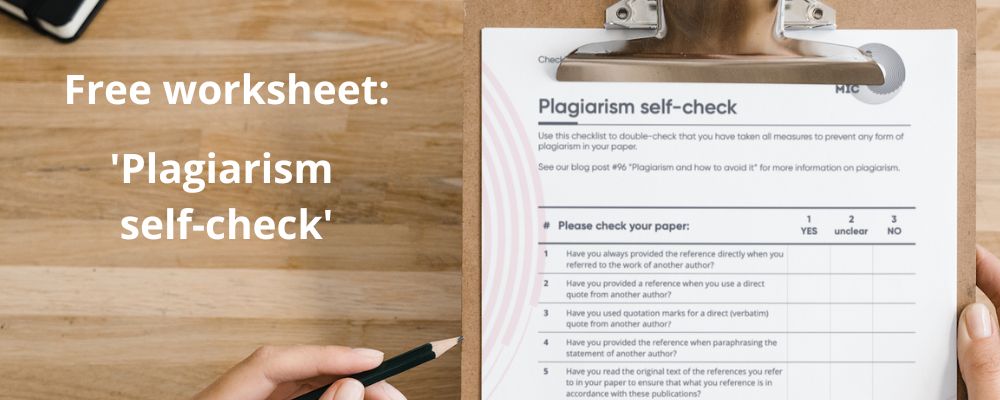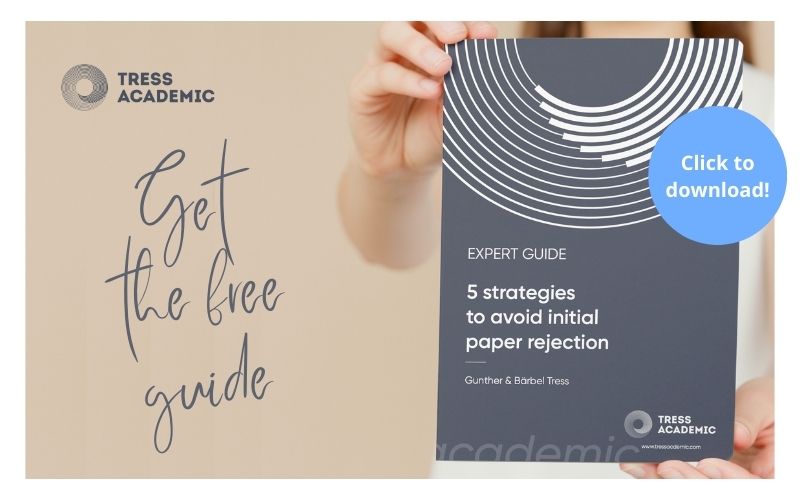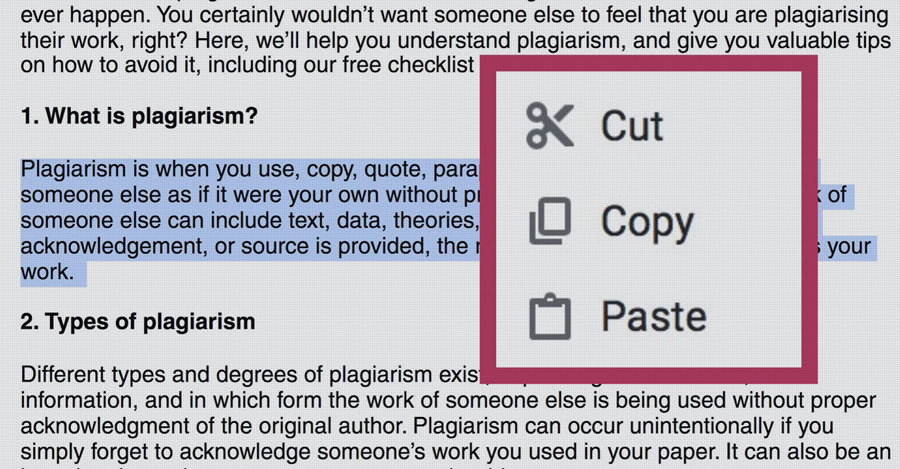Are you afraid that you will be accused of plagiarising ideas from other researchers in your paper? Are you worried that someone else is using your work without referencing it? In this post, learn what plagiarism is and how you can avoid it in your next research paper. Use our free checklist to check your paper for plagiarism.
What would you think if you read a paper in one of your favourite journals and after a few pages, get the impression that the ideas in this paper sound very familiar? After a while, you’re sure that the author of this paper has been reading and using your own work. Your first reaction might be very positive—there’s a colleague using your work, how exciting—but then you realise that nowhere are you mentioned in this paper. All your good ideas are presented, but your paper this author took them from is not even mentioned.
Such a case of plagiarism is no fun! You don’t feel good about it, and don’t want this to ever happen. You certainly wouldn’t want someone else to feel that you are plagiarising their work, right? Here, we’ll help you understand plagiarism, and give you valuable tips on how to avoid it, including our free checklist “Plagiarism self-check.”

1. What is plagiarism?
Plagiarism is when you use, copy, quote, paraphrase, or summarise the work of someone else as if it were your own without proper acknowledgement. The work of someone else can include text, data, theories, illustrations, or ideas. If no credit, acknowledgement, or source is provided, the reader of your text will assume it is your work.
2. Types of plagiarism
Different types and degrees of plagiarism exist, depending on how much, what information, and in which form the work of someone else is being used without proper acknowledgment of the original author. Plagiarism can occur unintentionally if you simply forget to acknowledge someone’s work you used in your paper. It can also be an intentional act when you want to present other ideas as your own.
Common types of plagiarism include:
- Plagiarism of ideas: including a major thought of another researcher in your work without giving this researcher the credit for the work.
- Patchwork plagiarism: including several short texts or sentences from various sources and incorporating them into your paper. It is a copy and paste exercise where little of your own thought is included. Even if the text is rephrased but the essential content comes from another, unacknowledged source, it is a case of plagiarism.
- Self-plagiarism: recycling your own previously published work (text, data, images) in another paper without proper citation. It creates redundant information, and masquerades as the presentation of new work.
- Complete or global plagiarism:copying an entire paper from someone else and submitting it under your name to another journal, and pretending it is your work (believe it or not, we once had such a case in our journal!).
3. What is not plagiarism?
There are cases where overlap between your paper and other published papers can happen without this being considered plagiarism:
- When you use similar references as those published in another paper.
- When you use a similar or standardised method and describe this method in general terms.
- When you re-use sentences from an earlier version of your paper that was e.g. published as a working paper on a non-commercial preprint server and when you inform the journal editor and the readers about this fact.
- When you use material from protocols of clinical trials that were posted on publicly accessible registries (see the specific requirements described in ICMJE 2019).
Plagiarism does not mean that you cannot use the ideas and work of other researchers. You can and many times you should do so, but make clear which material is yours and which is not through citation.
4. Why does plagiarism matter?
Plagiarising the work of somebody else is an ethical issue. An author submitting plagiarised work to a journal is committing intellectual theft. The consequences of plagiarism are clear:
- You undermine trust in the value of scholarly publications. The integrity of the academic publishing system gets damaged.
- You place doubts on the trustworthiness of your entire paper and your other works as you are obviously willing to mislead readers.
- You give false information about your qualification and expertise.
- You deny crediting the original author of the work.
- You violate ethical and copyright rules.
- Self-plagiarism increases the repetition of published work. It might get more difficult to differentiate original from repetitive work, which can lead to a distorted picture of published evidence on a certain research problem.
In contrast, by avoiding plagiarism and citing sources, you strengthen the authority of your work. You demonstrate that you have engaged with other work on the subject you are writing about.

5. How is plagiarism detected?
Work that is plagiarising other work can be detected at various stages:
a) In peer-review: If peer-reviewers suspect a case of plagiarism when reviewing a paper, they are expected to inform the journal editors who will further investigate the case.
b) In production: Checking a paper for potential plagiarism has become a standard procedure for many publishers in the production process. They can screen all papers in the process using plagiarism detection software (e.g. Turnitin, CrossRef Similarity Check).
c) After publication: In some cases, plagiarism is detected by a reader of the published paper. This reader should inform the journal or the publisher so that they can further investigate and take action against the plagiarising author.
Whereas it is relatively easy to detect and assess overlapping text and sentences by plagiarism software, it is more difficult for editors and journal staff to grasp and judge the plagiarising of ideas.
Depending on at which stage plagiarism is detected in a paper (in peer-review, in production, or after publication) different actions can be taken starting from a simple request for revision and proper acknowledgments of sources to rejection or retraction of the paper. The latter might involve informing the plagiarising author’s institution. Further information on how cases of plagiarism are dealt with can be found on the website of the Committee on Publication Ethics (COPE).
6. How to avoid plagiarism?
There’s one simple rule that helps you avoid being accused of plagiarism: Always cite the original sources for ideas, text, data, or images borrowed from other works!
To do this appropriately:
- Make it clear in your text what information is from another author, and mark it with quotation marks.
- Also provide a reference to papers and other work when you rephrase info from it in your own words.
- Clearly indicate the original source within your text depending on which referencing system and citation-rules you are using.
- Include the original source in your list of references.
- Reference appropriately while you’re writing your text, not afterwards. You might forget or miss a reference you should acknowledge. Whenever you work on your paper, or read other papers that later might be referenced in your paper, write down the reference of these papers in your current paper right away.
- If required, make sure you have permission from the copyright holder to include a figure or image. The copyright holder might be the author or the journal’s publisher.
To keep away from the stress of being accused of plagiarism, plan and start the writing of your paper early so that you don’t fall under time-pressure. Keep track of all your sources while reading and writing. To make sure that you’re not being accused of plagiarism, we’ve created a “Plagiarism self-check” that you can download for free and apply to your next paper.

Conclusion
Avoiding plagiarism is straightforward and a must-do for any good researcher! If you follow the rules mentioned above, you should be on the safe side. Sometimes, we know, there’s a fine line between where the ideas of other people end and where your own ideas start. In that case, we suggest you be generous and cite the other ideas—it makes your work more inclusive as you demonstrate that you used and were inspired by other researchers’ thoughts. Use our free checklist “Plagiarism self-check” to make sure you have not forgotten to provide any reference.

Relevant resources:
- Checklist “Plagiarism self-check”
- Blog post #79: 5 decisions that make writing your paper so much easier.
- Blog post #67: Writing productivity: Write more in less time.
- Blog post #62: Twenty things you should know when writing a journal paper.
- COPE (Committee on Publication Ethics)
- Helgesson, G., Eriksson, S. 2015. Plagiarism in research. Medicine, Health Care and Philosophy 18, 91–101. https://doi.org/10.1007/s11019-014-9583-8
- ICMJE (International Committee of Medical Journal Editors) 2019. Recommendations for the Conduct, Reporting, Editing, and Publication of Scholarly Work in Medical Journals.
- Plagiarism Blog by Turnitin
- Roig, M. 2015. Avoiding plagiarism, self-plagiarism, and other questionable writing practices: A guide to ethical writing. The Office of Research Integrity.
- Scribbr 2019. How to avoid plagiarism.
- Taylor & Francis plagiarism policies and guidance for authors
More information
Do you want to successfully write and publish a journal paper? If so, please sign up to receive our free guides.
© 2021 Tress Academic
